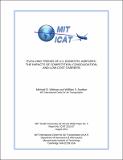| dc.contributor.author | Wittman, Michael D. | |
| dc.contributor.author | Swelbar, William S. | |
| dc.date.accessioned | 2013-08-15T19:20:41Z | |
| dc.date.available | 2013-08-15T19:20:41Z | |
| dc.date.issued | 2013-08-15 | |
| dc.identifier.uri | http://hdl.handle.net/1721.1/79878 | |
| dc.description.abstract | This paper investigates the effects of flight reductions and disciplined airline capacity management strategies on average one-way domestic airfares at 445 U.S. airports from 2007-2012. Average one-way airfares are found to have increased at most airports during the study period, adjusting for inflation. Secondary and tertiary airports in multi-airport regions often saw larger increases in average fares than primary airports in those regions. The effects of low-cost carriers (LCCs) such as Southwest Airlines and JetBlue Airways on average one-way fares are also investigated. While the presence of low-cost carriers is still associated with a downward pressure on fares, the famous "Southwest effect" has diminished over time. Instead, JetBlue Airways is now the airline that is associated with the largest decline in average fares at U.S. airports. | en_US |
| dc.description.sponsorship | MIT Airline Industry Consortium | en_US |
| dc.relation.ispartofseries | ICAT;2013-07 | |
| dc.subject | air transportation | en_US |
| dc.subject | flight reductions | en_US |
| dc.subject | airline capacity | en_US |
| dc.subject | airfares | en_US |
| dc.subject | low-cost carriers | en_US |
| dc.title | Evolving Trends of U.S. Domestic Airfares: The Impacts of Competition, Consolidation, and Low-Cost Carriers | en_US |
| dc.type | Technical Report | en_US |
